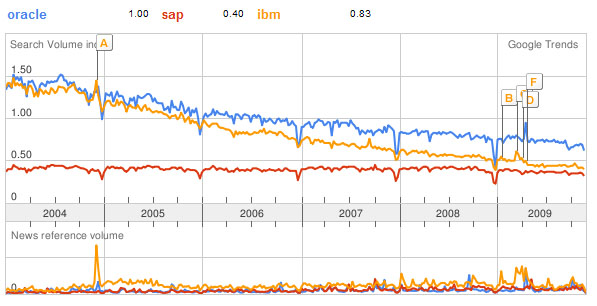
 The term OLAP or Online Analytic Processing was coined in 1993 by relational database technology pioneer Ted Codd (my claim to fame: we went to the same high school, Poole Grammar).
The term OLAP or Online Analytic Processing was coined in 1993 by relational database technology pioneer Ted Codd (my claim to fame: we went to the same high school, Poole Grammar).
The term was chosen to contrast with OLTP or online transaction processing, and was prompted by some clever marketing folks at Essbase, who wanted to promote their multidimensional database product. Codd was famous for his twelve rules defining the relational model and duly came up with twelve rules for analytic systems.
The term was quickly taken up by the rest of the industry, and spawned new definitions (Nigel Pendse’s FASMI test) and multiple variations (MOLAP, HOLAP, ROLAP, Huey, Dewie and Louie, etc.).
Over time, these multiple definitions started muddying the meaning of the term (was it a technology? a user interface? an approach to analysis?), and Gartner decreed that it was ‘just’ part of a larger market called business intelligence. The result has been a long slow decline of the use of the term OLAP, as the Google Trends chart below indicates.

Only Nigel Pendse of the OLAP Report tried to side-step this trend, and continued producing OLAP-specific analysis for many years, but “business intelligence” was clearly the mainstream industry term. A few years ago, Nigel sold the OLAP Report to the German BARC group, who initially continued under the same name, and tried vainly to convince everybody that OLAP was still a “hip term”, but finally succumbed to the inevitable and announced last month that they would be changing the name of the report/site to The BI Verdict.
(Sadly, at some point in this process, BARC decided to lock one of Nigel’s best articles — “How not to buy a BI product” – behind their subscription firewall. All I can find on the web is a far-less-entertaining summary of the main points here. [UPDATE: thanks to a tip from Florian Bahr, I can point you to the full article on the WayBackMachine: How not to buy an OLAP product)
Since BARC were the last group using the term with any frequency, it’s now fairly safe to say that OLAP’s days are over, but interestingly, the group seems to have chosen to shift to the wrong term. The chart below shows that the search trend for “business intelligence” has been slowly drifting down over the last five years.

And the decline is even more pronounced for another standard industry term, “performance management”

Since BI and performance management remain fast-growing markets, this trend is a little surprising – until you look at the search figures for the term analytics. Starting in 2005 (perhaps prompted by the introduction of Google Analytics?), the term has skyrocketed in use.

Possible reasons for this may include:
- Popular books and articles aimed as business people tend to use the term, such as Thomas Davenport’s 2007 book “Competing on Analytics”. This is perhaps because there’s more ambiguity for a business audience, who associate the term “business intelligence” with industry data vendors like Reuters and Thomson (now both part of the same company).
- The acquisition of the mainstream BI vendors by larger organizations (Hyperion by Oracle, Cognos by IBM, and BusinessObjects by SAP) has meant that the industry has been increasingly using other, more generic terms, such as “embedded analytics” and “analytic applications” to explain the same functionality. And the largest remaining independent vendor, SAS, has proclaimed themselves the leader in “business analytics”
My conclusion? By the time you read this, this blog might well be called “Analytic Questions” instead of “BI Questions”…

Comments
16 responses to “OLAP is Dead (Long Live Analytics)”
To be honest, none of these names are very good.
OLAP is quite old fashioned. The “online” part is especially odd when you are referring to off line tool. I suppose this is “off line on line analytic processing”. Also the term “processing” harks back to the days when computers were exotic and expensive, and batch processing was high tech. Today processor cost almost nothing and we tend to think more in terms of the user.
Business Intelligence seems to mean the data companies use for analysis. It has a slightly spooky overtone. But more important it overlaps the term “business intelligence” meaning information about companies. This is painfully obvious at aggregation sites like Alltop, where the business intelligence as it is meant here gets swamped by news sites. I blogged about this recently. Also business intelligence is a mouthful and the abbreviation, BI, has issues with ambiguity as well.
And as Seth pointed out already, “analytics” gets swamped Web analytics.
So maybe someone should come up with a new name?
Thanks for the flash back. In the 1990s I met Nigel Pendse when he was with Comshare and I was getting to learn System W (the precursor to Essbase). Then I worked with Ralph Kimball and got to know the Red Brick team, where we battled against the OLAP issue with prospects. That was why we used to like partnering with a new crowd called BusinessObjects. And at the same time I came across a guy on Compuserve called Neil Raden of Archer Data Systems 🙂
You probably could have been more explicit when referring to Gartner and BI – it was of course Howard Dresner.
Timo,
Talk about colorful history.
I mentioned a while back that Dorrian and Earle and I worked in the same software company back in the early 80’s (about 100 of us), but it was only two months ago I found out another interesting connection. At the Tableau Software conference, someone approached me and said “Hi Neil.” I had no idea who he was. Then he asked, “How’s Susie?” That’s my wife. “How are Mara, Aja and Jake?” Oh boy, those are my three oldest kids (I have five). So I figured I must have known him from New York, because we had only three kids when we moved to California. With a little chit-chat I finally figured out that he was one of the SE’s who worked for me in New York and was also the first person I hired into my consulting company when I started it in 1985.
Then he asked me, “Do you remember a salesman in our office named Joe?” I sad, “Sure, Joe Germanotta, I remember him well. Flashy dresser, big personality.” Steve said, “Do you remember that he and his wife had a baby girl when you were still working there?” “Sure,” I said, “we all chipped in and both her a baby gift.”
“Do you you know who that baby is now?”
“Nope,” I said, “no idea.”
“Lady GaGa.”
Yeah, I would say that the trend is likely due to the term Google Analytics creating a household knowledge of ‘analytics’. The dips and mountains fit.
http://www.google.com/insights/search/#q=analytics%2Cgoogle%20analytics%2Cweb%20analytics%2Cwebsite%20analytics&cmpt=q
[…] OLAP is Dead (Long Live Analytics) OLAP vs. BI smackdown […]
Neat post . I did a similar thing doing keyword searches on trade press articles a few years ago – and over a much longer time period (the databases go back decades) – using terms like “decision support” “executive information systems” etc. I figured the number of times trade press used a term was some sort of surrogate for the popularity of the term. The curves exactly match a product life cycle curve – the terms come in an out of fashion just like consumer products.
With my colleague, David Arnott, I published a paper on the rise and fall of the term “Business process reengineering” which also matched a product life cycle curve.
OLAP is a great example of that – early its just for innovators, later as it becomes more established there are variations (ROLAP, MOLAP etc) just like a consumer product – think blue lines in tooth paste to make one brand seem different or better to the others. Now its in decline and it’s being replaced – this isn’t a passive process either I don’t think – it is driven by the vendors. They do have products to sell and using the same terms for years and year doesn’t work, so its no accident that popularity of the terms matches a product life cycle.
One last comment, I think Tom Davenport’s book on analytics has been an important boost in the rise of the use of that term in our context – Seth’s comment about its use in web analytics is a good point, but I’ve always thought of web analytics as a subset of what we do anyway. The term has been around for a very long time but is as you show is only now becoming popular.
POD
Timo, judging by the Google Trends charts for “Business Objects” and “SAP”, those are slowly dying as well.
Good point! BusinessObjects going down makes sense — it’s now a sub-brand of a much bigger group. SAP looks pretty stable (slightly more than business intelligence?). What’s really interesting is this chart, comparing SAP with Oracle and IBM:

Just FYI, I just came up with an explanation for this. As Seth points out, the volumes are relative. So the declines of Oracle and IBM are mainly due to the fact that Google search is going beyond the early adopters (who tended to search for technical terms) to the general population (where vendor searches get buried by Paris or Perez Hilton). But why would SAP stay steady? Because, unlike IBM and Oracle, business people actually know they’re using SAP — IBM sells infrastructure, and most of the Oracle search terms are to do with the database. Sound reasonable?
Barney, a precision about my view of “analytics.” My take is that business analytics is a subset of business intelligence, one part of a larger BI toolkit. If we had a comprehensive BI-analytics taxonomy, we would see Web analytics as a variety of BI. It’s not seen that way because analytical tools are siloed by application — some are broad, some focused — and Web and so-called business analytics are in different silos.
Timo,
I don’t think the point Carsten was trying to make was that OLAP was a hip term. The point was more that they part of BI that was OLAP is not out of style, even if the name is.
In fact it’s been clear to all of us a BARC (including Nigel) for some time that the term OLAP is losing popularity. but I agree with Seth and Neil about “analytics” — it means a lot more than just BI.
We did a lot of head scratching before picking the name, but we’re pretty satisfied with the result. 😉
Barney Finucane
Timo,
It was a master stroke. Dorrian and co-founder Bob Earle were co-workers of mine in a little software company. The rest of us watched in wonder as they pulled this off. There were some other familiar people there, too, like John Kopcke, etc. Anyway, the fact that the whole thing blew up in Codd’s face gave them a second, much larger round of publicity, Whether Jim was diabolical enough to forsee this, I can’t say. It’s nice, though, that our industry has some colorful history.
-NR
“Analytics” grew rapidly in popularity because of Web Analytics, which is quite simplistic software to analyze Web logs, rather than because of the Business Analytics usage.
More important, I believe you are misconstruing Google’s search volume index. According to http://www.google.com/intl/en/trends/about.html, the SVI reports “how many searches have been done for the terms you enter, relative to the total number of searches done on Google over time.” So a decrease in the SVI does NOT mean a term is searched for less frequently. We do NOT necessarily have “a long slow decline of the use of the term OLAP.” The number of searches for “OLAP” could be increasing — I don’t know if it actually is or not — just more slowly than the total number of searches, leading to a decrease in the SVI. The stats you show don’t give a complete picture.
Seth
Seth, thanks for the added information about the trends index. I still think it seems reasonable to suppose that analytics is the term that we’ll see more of in the future, especially as web analytics starts merging with more general business analytics (and this trend is accelerating as organizations start analyzing social media with the “voice of the customer” analytics you wrote about in your study). Unless a big vendor (or open-source provider) decides to clearly label their solution as “OLAP”, I think the use of the term is likely to (continue to?) decline…
Timo,
I think you made an assumption that the rise in hits on “analytics” is directly related to the dropoff in “OLAP.” But as you yourself said, the term “analytics” was inserted into the mainstream by Davenport and searches on just that word, I suspect, cover a far broader subject than OLAP. Also, davenport’s book was released in 2007, not 1997, though he had a paper published from Babson and a HBR article of the same title around 2005.
To me, the EKG for Business Intelligence looks fairly flat, with the recent downward trend possibly the result of reduced economic activity.
In any case, it’s hard to escape that OLAP is toast, at least as a term. Interestingly, though, Gartner still weighs it heavily in their magic quardrant analysis of BI tools.
Also, of historical note, Codd was commissioned by Jim Dorrian, one of the co-founders of Arbor Software, to write the 12 Rules of OLAP. It was published in ComputerWorld with great hoopla in 1993, but when it was discovered that Codd was paid by Arbor, ComputerWorld retracted it and it almost ruined Codd’s reputation.
I love our dumb little business.
-NR
Neil — I guess I was tired yesterday. I fixed the typo on the date. I agree the decline in BI is relatively minor. Maybe that’s because it remains the mainstream term for us industry insiders and implementers, while the newcomers and users of the technology tend towards the term “analytics”?
I completely agree that analytics is a broader term than OLAP, and many thanks for the mention of Jim Dorrian — I wanted to give credit where it was due: I think it was the one of the best marketing moves I’ve seen in the industry over the last eighteen years or so…